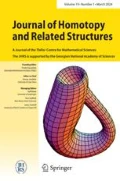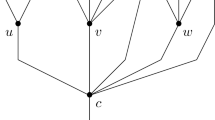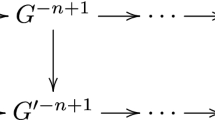Abstract
In this paper we study N-differential graded categories and their derived categories. First, we introduce modules over an N-differential graded category. Then we show that they form a Frobenius category and that its homotopy category is triangulated. Second, we study the properties of its derived category and give triangle equivalences of Morita type between derived categories of N-differential graded categories. Finally, we show that this derived category is triangle equivalent to the derived category of some ordinary differential graded category.
Similar content being viewed by others
References
Beilinson, A. A., Bernstein, J., Deligne, P.: ‘Faisceaux Pervers’, Astérisque 100 (1982)
Dubois-Violette, M.: \(d^N=0\): Generalized Homology. K-Theory 1 4(4), 371–404 (1998)
Dubois-Violette, M.: Generalized differential spaces with \(d^N=0\) and the \(q\)-differential calculus, Quantum groups and integrable systems, I (Prague, 1996). Czechoslovak J. Phys. 46(12), 1227–1233 (1996)
Dubois-Violette, M., Kerner, R.: Universal \(q\)-differential calculus and \(q\)-analog of homological algebra. Acta Math. Univ. Comenian. (N.S.) 65(2), 175–188 (1996)
Happel, D.: Triangulated categories in the representation theory of finite-dimensional algebras, London Mathematical Society Lecture Note Series, 119. Cambridge University Press, Cambridge (1988)
Iyama, O., Kato, K., Miyachi, J.: Derived categories of N-complexes. J. Lond. Math. Soc. (2) 96(3), 687–716 (2017)
Iyama, O., Kato, K., Miyachi, J.: Polygon of recollements and N-complexes. arXiv:1603.06056 (2016)
Kapranov, M.M.: On the q-analog of homological algebra. Cornell University, Ithaca (1991).. (Preprint, q-alg/961005)
Keller, B.: Deriving DG categories. Ann. Sci. École Norm. Sup. (4) 2(7), 63–102 (1994)
Kelly, G.M.: Basic Concepts of Enriched Category Theory London Mathematical Society Lecture Note Series, vol. 6 4. Cambridge University Press, Cambridge (1982)
Krause, H.: A Brown representability theorem via coherent functors. Topology 4(1), 853–861 (2000)
Krause, H.: Derived categories, resolutions, and Brown representability. In: Interactions between Homotopy Theory and Algebra. Summer School, University of Chicago, IL, USA, July 26–August 6, 2004. Providence, RI, American Mathematical Society (AMS), Contemporary Mathematics 436, pp. 101–139 (2007)
Mayer, W.: A new homology theory I, II. Ann. Math. 43, 594–605 (1942)
Miyachi, J.: Localization of triangulated categories and derived categories. J. Algebra 141, 463–483 (1991)
Neeman, A.: Triangulated Categories. Annals of Mathematics Studies, vol. 148. Princeton University Press, Princeton (2001)
Quillen, D.: Higher Algebraic K-Theory I, vol. 341, pp. 85–147. Springer LNM, New York (1973)
Sitarz, A.: Andrzej, On the tensor product construction for q-differential algebras. Lett. Math. Phys. 44(1), 17–21 (1998)
Yang, X., Ding, N.: The homotopy category and derived category of N-complexes. J. Algebra 426, 430–476 (2015)
Acknowledgements
We would like to thank the referee and the editor for valuable suggestions.
Author information
Authors and Affiliations
Corresponding author
Additional information
Communicated by Claude Cibils.
Dedicated to the Memory of Professor Mitsuo Hoshino.
Publisher's Note
Springer Nature remains neutral with regard to jurisdictional claims in published maps and institutional affiliations.
5 Appendix
5 Appendix
In this section, we give the following results concerning Frobenius categories and triangulated categories. Let \(\mathcal {C}\) be an exact category with a collection \(\mathcal {E}\) of exact sequences in the sense of Quillen [16]. An exact sequence \(0 \rightarrow X \xrightarrow {f} Y \xrightarrow {g} Z \rightarrow 0\) in \(\mathcal {E}\) is called a conflation, and f and g are called an inflation and a deflation, respectively. An additive functor \(F: \mathcal {C} \rightarrow \mathcal {C}'\) is called exact if it sends conflations in \(\mathcal {C}\) to conflations in \(\mathcal {C}'\). An exact category \(\mathcal {C}\) is called a Frobenius category provided that it has enough projectives and enough injectives, and that any object of \(\mathcal {C}\) is projective if and only if it is injective. In this case, the stable category \(\underline{\mathcal {C}}\) of \(\mathcal {C}\) by projective objects is a triangulated category (see [5]). This stable category is called an algebraic triangulated category.
Proposition 4.3
([7] Proposition 7.3) Let \((\mathcal {C}, \mathcal {E}_{\mathcal {C}}), (\mathcal {C}, \mathcal {E}_{\mathcal {C}'})\) be Frobenius categories, \(F: \mathcal {C} \rightarrow \mathcal {C}'\) an exact functor. If F sends projective objects of \(\mathcal {C}\) to projective objects of \(\mathcal {C}'\), then it induces the triangle functor \({\underline{F}} : \underline{\mathcal {C}} \rightarrow \underline{\mathcal {C}}'\).
Let \(\mathcal {D}\) be a triangulated category with arbitrary coproducts. An object U in \(\mathcal {D}\) is compact if the canonical morphism \(\coprod _{i}{\text {Hom}}_{\mathcal {D}}(U, X_i)\rightarrow {\text {Hom}}_{\mathcal {D}}(U, \coprod _{i }X_i)\) is an isomorphism for any set \(\{X_i \}\) of objects in \(\mathcal {D}\). A triangulated category \(\mathcal {D}\) is called compactly generated if there is a set \({\mathsf {U}}\) of compact objects such that \({\text {Hom}}_{\mathcal {D}}({\mathsf {U}}, X) = 0\) implies \(X=0\) in \(\mathcal {D}\).
Theorem 4.5
Let \(\mathcal {D}\) be a compactly generated triangulated category with a set \({\mathsf {U}}\) of compact generators for \(\mathcal {D}\). Let \(F: \mathcal {D} \rightarrow \mathcal {D}'\) be a triangle functor between triangle categories such that F preserves coproducts. Then the following are equivalent.
-
(1)
F is a triangle equivalence.
-
(2)
-
1.
\(F({\mathsf {U}})\) is a set of compact generators for \(\mathcal {D}'\).
-
2.
\({\text {Hom}}_{\mathcal {D}}(U, V) \rightarrow {\text {Hom}}_{\mathcal {D}'}(FU,FV)\) is an isomorphism for any \(U, V \in {\mathsf {U}}\).
-
1.
Proof
(1) \(\Rightarrow \) (2) Trivial.
(2) \(\Rightarrow \) (1) We may assume that \({\mathsf {U}}=\Sigma {\mathsf {U}}\). Let \(\mathcal {U}\) be the full subcategory of coproducts of objects U in \({\mathsf {U}}\). Let \(<\mathcal {U}>_0:=\mathcal {U}\). For \(n \ge 1\) let \(<\mathcal {U}>_n\) be the full subcategory of \(\mathcal {D}\) consisting of objects X such that there is a triangle \(U \rightarrow V \rightarrow X \rightarrow \Sigma U\) with \(U \in <\mathcal {U}>_0\), \(V \in <\mathcal {U}>_{n-1}\). Given \(U \in {\mathsf {U}}\), for any \(U_i \in {\mathsf {U}}\) \((i \in I)\), we have a commutative diagram

such that all vertical arrows are isomorphisms. Therefore, for any \(V \in \mathcal {U}\) we have the canonical morphism \({\text {Hom}}_{\mathcal {D}}(U, V) {\mathop {\rightarrow }\limits ^{\sim }}{\text {Hom}}_{\mathcal {D}'}(FU, FV)\) is an isomorphism. For any \(W\in <\mathcal {U}>_n\) we have a triangle \(U' \rightarrow V \rightarrow W \rightarrow \Sigma U\) with \(U' \in <\mathcal {U}>_0\), \(V \in <\mathcal {U}>_{n-1}\). Applying \({\text {Hom}}_{\mathcal {D}}(U, -)\) to this triangle, by the induction the five lemma implies that the canonical morphism \({\text {Hom}}_{\mathcal {D}}(U, W) {\mathop {\rightarrow }\limits ^{\sim }}{\text {Hom}}_{\mathcal {D}'}(FU, FW)\) is an isomorphism. According to Brown’s representability theorem (e.g. [15]), for any \(Y \in \mathcal {D}\), there is a sequence \(Y_0 \rightarrow Y_1 \rightarrow \cdots \) with \(Y_i \in <\mathcal {U}>_i\) which has a triangle
Applying \({\text {Hom}}_{\mathcal {D}}(U, -)\) to this triangle, the five lemma implies that the canonical morphism \({\text {Hom}}_{\mathcal {D}}(U, Y) {\mathop {\rightarrow }\limits ^{\sim }}{\text {Hom}}_{\mathcal {D}'}(FU, FY)\) is an isomorphism. Similarly, by the induction on n for any \(W \in <\mathcal {U}>_n\), any \(Y \in \mathcal {D}\) the canonical morphism \({\text {Hom}}_{\mathcal {D}}(W, Y) {\mathop {\rightarrow }\limits ^{\sim }}{\text {Hom}}_{\mathcal {D}'}(FW, FY)\) is an isomorphism. Brown’s representability theorem implies that the canonical morphism \({\text {Hom}}_{\mathcal {D}}(X, Y) {\mathop {\rightarrow }\limits ^{\sim }}{\text {Hom}}_{\mathcal {D}'}(FX, FY)\) is an isomorphism for any \(X. Y \in \mathcal {D}\). Then F is fully faithful. Therefore we have \(<F(\mathcal {U})>_i= F(<\mathcal {U}>_i)\) for any i. Since \(F({\mathsf {U}})\) is a set of compact generator for \(\mathcal {D}'\), for any \(Z \in \mathcal {D}'\), there is a sequence \(Z_0 \xrightarrow {\beta _0} Z_1 \xrightarrow {\beta _1} \cdots \) with \(Z_i \in <F(\mathcal {U})>_i\) which has a triangle
Then there is a morphism \(\alpha _i:X_i \rightarrow X_{i+1}\) such that \(F\alpha _i=\beta _i\) for any i. Let X be the homotopy colimit of the sequence \(X_0 \xrightarrow {\alpha _0} X_1 \xrightarrow {\alpha _1} \cdots \), then we have a commutative diagram

where the first, second, fourth vertical arrows are isomorphisms. Then the third vertical arrow is an isomorphism. Therefore F is dense, and hence a triangle equivalence. \(\square \)
Rights and permissions
About this article
Cite this article
Miyachi, Ji., Nagase, H. Derived categories of NDG categories. J. Homotopy Relat. Struct. 16, 191–224 (2021). https://doi.org/10.1007/s40062-021-00279-3
Received:
Accepted:
Published:
Issue Date:
DOI: https://doi.org/10.1007/s40062-021-00279-3




